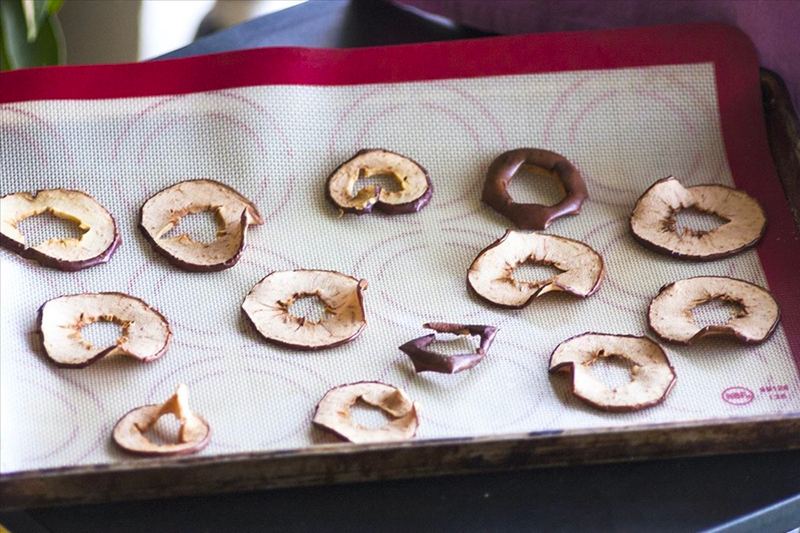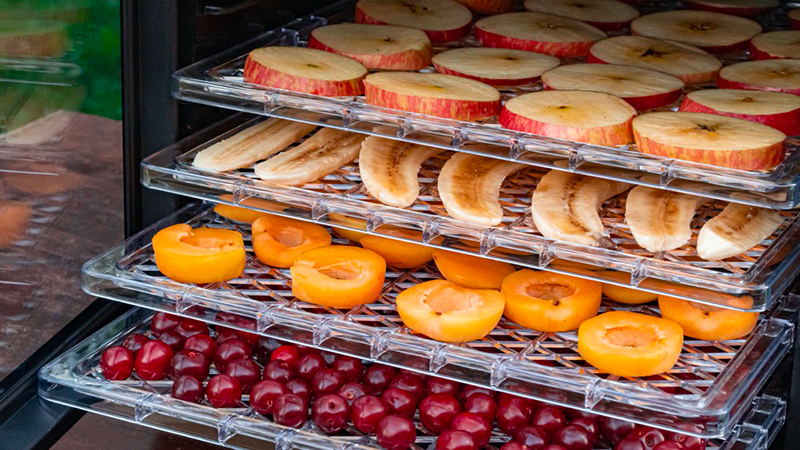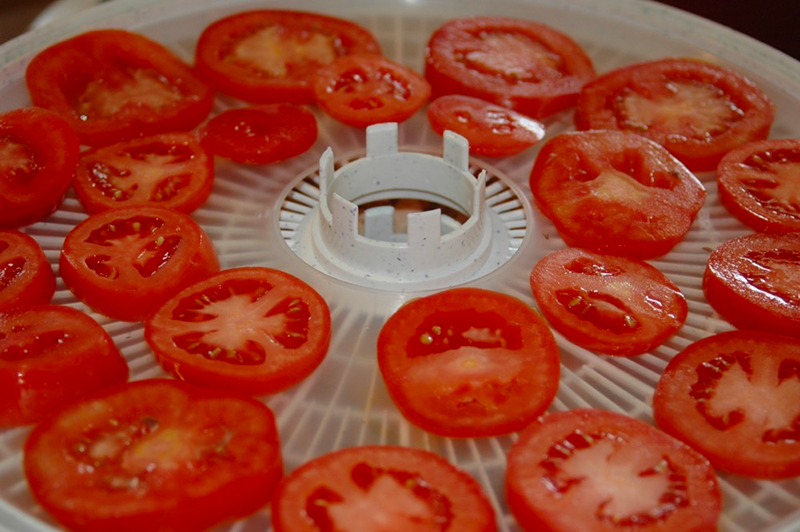
Content Menu
● Understanding Dehydration
● Benefits of Dehydrating Food
● Methods to Dehydrate Food Without a Dehydrator
>> 1. Oven Drying
>> 2. Sun Drying
>> 3. Toaster Oven
>> 4. Microwave Drying
>> 5. Car Drying
● Tips for Successful Dehydration
● Dehydrating Specific Foods
>> Fruits
>> Vegetables
>> Herbs
● Storing Dehydrated Foods
● Conclusion
● FAQ
>> 1. Can I dehydrate any type of fruit?
>> 2. How do I know when my food is fully dehydrated?
>> 3. Is it necessary to blanch vegetables before dehydration?
>> 4. How should I store my dehydrated foods?
>> 5. Can I use herbs directly from my garden?
● Citations:
Dehydrating food is an excellent way to preserve the nutritional value of fruits, vegetables, and meats while minimizing waste. While many people rely on electric dehydrators for this process, there are several effective methods to dehydrate food without one. This article will explore various techniques, tips, and tricks to help you successfully dehydrate food using common kitchen appliances and natural elements.

Understanding Dehydration
Dehydration is the process of removing moisture from food, which inhibits the growth of bacteria, yeasts, and molds. Foods like fruits and vegetables are composed of 80-95% water, while meats contain 50-75% water. By reducing the moisture content to below 20%, you can significantly extend the shelf life of these foods.
Benefits of Dehydrating Food
- Preservation: Dehydrated foods can last for months or even years without refrigeration.
- Nutritional Retention: Dehydration helps retain most vitamins and minerals compared to other preservation methods like canning.
- Space-Saving: Dried foods take up significantly less space than their fresh counterparts.
- Flavor Enhancement: The dehydration process concentrates flavors, making dried fruits and vegetables taste sweeter and more intense.
Methods to Dehydrate Food Without a Dehydrator
1. Oven Drying
Using your oven is one of the simplest ways to dehydrate food. Here's how:
- Preparation: Slice fruits or vegetables into uniform pieces about ¼ inch thick. For fruits like apples or pears, soak them in a mixture of lemon juice and water for five minutes to prevent browning.
- Temperature Setting: Preheat your oven to its lowest setting (ideally between 120°F to 140°F or 49°C to 60°C). If your oven doesn't go that low, prop the door open slightly to allow moisture to escape.
- Drying Process: Place the food on a baking sheet lined with parchment paper or a silicone mat. Ensure there is enough space between pieces for air circulation. Drying times can vary from 6 to 10 hours depending on the type of food and thickness of slices.
- Monitoring: Rotate the trays every hour for even drying. Check for doneness; fruits should be leathery but not sticky, while vegetables should be brittle.
2. Sun Drying
Sun drying is an ancient method that works well in hot, dry climates.
- Preparation: Slice fruits or vegetables thinly and lay them out in a single layer on a clean mesh screen or tray.
- Location: Place the tray in a sunny spot with good airflow. Cover with cheesecloth or another mesh material to keep insects away.
- Timeframe: Depending on the weather conditions, this method can take several days. Ensure you bring the food inside at night to avoid moisture accumulation.
3. Toaster Oven
A toaster oven can be an excellent alternative for small batches.
- Setup: Similar to oven drying, set your toaster oven to its lowest setting and leave the door ajar for airflow.
- Process: Arrange food on the racks or trays provided with your toaster oven. Keep an eye on it as toaster ovens can heat unevenly.
4. Microwave Drying
While not traditional, microwaving can effectively dehydrate certain foods quickly.
- Method: Place sliced fruits or herbs in a single layer on a microwave-safe plate. Use a low power setting (defrost mode) and check every few minutes until dried.
- Caution: This method requires careful monitoring as microwaves can cook food rather than dehydrate it if left too long.

5. Car Drying
This innovative method utilizes your car as a solar dehydrator.
- Preparation: On a sunny day, slice fruits or vegetables thinly and spread them out on a cooling rack placed on your dashboard.
- Process: Close the car windows and let the sun work its magic throughout the day. This method can take several hours but is energy-efficient and effective.
Tips for Successful Dehydration
- Always wash your produce thoroughly before dehydrating.
- Cut all pieces uniformly for even drying.
- Consider blanching vegetables before dehydrating them to maintain color and texture; this involves briefly boiling them before drying.
- Store dehydrated foods in airtight containers in a cool, dark place to maximize shelf life.
- Experiment with different herbs and spices during dehydration for unique flavors in your finished products.
Dehydrating Specific Foods
Different foods require different approaches when it comes to dehydration:
Fruits
Fruits such as apples, bananas, peaches, and strawberries are popular choices for dehydration due to their natural sweetness.
- Preparation: Wash and slice fruits into uniform pieces. As mentioned earlier, soaking them in lemon juice prevents browning.
- Drying Time: Depending on thickness, fruit slices may take anywhere from 6 to 12 hours in an oven at low temperatures (around 135°F).
Vegetables
Vegetables like tomatoes, peppers, carrots, and zucchini are also great candidates for dehydration.
- Preparation: Wash thoroughly and slice into uniform pieces; blanching may enhance color retention.
- Drying Time: Most vegetables will take about 4 to 10 hours at temperatures around 125°F.
Herbs
Herbs such as basil, oregano, thyme, and rosemary are best dried at lower temperatures (around 95°F) to preserve their essential oils and flavors.
- Preparation: Simply wash and pat dry; you may choose to hang them upside down or lay them flat on a drying rack.
- Drying Time: Herbs typically take just a few hours until they crumble easily when rubbed between fingers.
Storing Dehydrated Foods
Once your food is adequately dehydrated, proper storage is crucial:
1. Ensure that all items have cooled completely before storing.
2. Use airtight containers such as glass jars or vacuum-sealed bags.
3. Label containers with the date of dehydration for tracking freshness.
4. Store in a cool, dark place away from direct sunlight; this helps prolong shelf life.
Conclusion
Dehydrating food without a dedicated dehydrator is not only possible but also practical using everyday kitchen appliances and natural sunlight. Whether you choose to use an oven, microwave, toaster oven, or even your car, each method has its unique benefits and processes that can yield delicious results. With patience and practice, you can enjoy home-dried snacks that are perfect for camping trips, hiking adventures, or simply as healthy snacks at home.

FAQ
1. Can I dehydrate any type of fruit?
Yes, most fruits can be dehydrated effectively; however, high-fat fruits like avocados are not suitable for dehydration as they may become rancid quickly.
2. How do I know when my food is fully dehydrated?
Fruits should be leathery but not sticky; vegetables should be brittle. If they feel moist or sticky, they need more drying time.
3. Is it necessary to blanch vegetables before dehydration?
Blanching is not strictly necessary but helps preserve color and texture in certain vegetables like carrots and broccoli.
4. How should I store my dehydrated foods?
Store dehydrated foods in airtight containers in a cool, dark place to maintain their quality for longer periods.
5. Can I use herbs directly from my garden?
Absolutely! Fresh herbs are excellent candidates for dehydration; simply wash them thoroughly before drying them using any of the methods mentioned above.
Citations:
[1] https://www.goodhousekeeping.com/appliances/a31904157/what-is-a-dehydrator/
[2] https://www.healthline.com/nutrition/dehydrated-food
[3] https://farmingmybackyard.com/dehydrating-foods-without-electricity/
[4] https://www.lowes.com/n/how-to/how-to-dehydrate-food
[5] https://www.freshoffthegrid.com/dehydrating-food/
[6] https://pedalshift.net/2014/05/dehydrating-ultralight-meals-without-dehydrator/
[7] https://cosori.com/blogs/blog/how-does-a-food-dehydrator-work
[8] https://www.campkitchen.ca/blog/dehydrating-basics
[9] https://www.cnet.com/home/kitchen-and-household/dont-have-a-dehydrator-use-your-oven/
[10] https://homesteadingfamily.com/preservation-101-intro-to-dehydrating-food/











